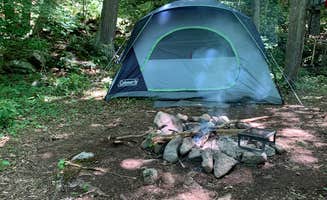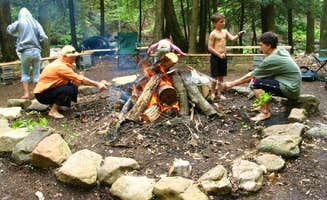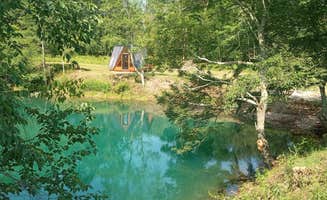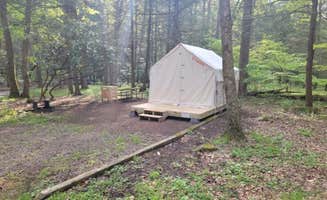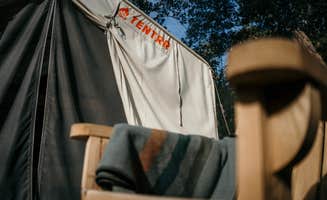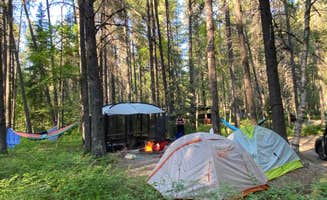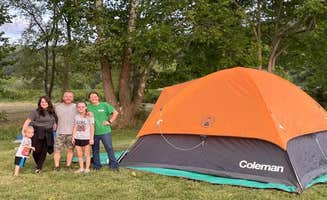Camping sites near Kitzmiller, Maryland offer varied terrain with elevations ranging from 1,500 to 3,000 feet throughout the Appalachian highlands. The region experiences cooler nighttime temperatures even in summer, often dropping into the 50s, making sleeping bags rated for lower temperatures necessary year-round. Primitive sites along waterways tend to fill by Friday afternoon during peak season from May through September.
What to do
Hiking nearby waterfalls: At Swallow Falls State Park, the largest waterfall in Maryland, Muddy Creek Falls, drops 53 feet. "The trails to the namesake falls are beautiful and very family-friendly, with lots of helpful signage. However, the parking lots and trailheads were PACKED on the weekend, so if you're a day tripper, get there early!"
Paddle on multiple waterways: The region offers both lake and river paddling options within short drives. "Herrington Manor which was right down the road was a great place to go kayaking while we were there," notes one camper who visited Swallow Falls State Park.
Fish in stocked waters: Streams and lakes throughout the area hold trout and other species. "The stream was incredible and lively with trout and crayfish," reports a camper at Big Run State Park, where stream access is available directly from many campsites.
Winter recreation: For those camping in colder months, the area transforms into a winter sports destination. "Swallow falls is awesome year round. In the winter the snow and ice is beautiful," notes a camper who gives the park five stars.
What campers like
Stream-side camping: Many campers value the water sounds for sleeping. At Big Run State Park, "The best spots are in the woods adjacent to the stream. You can set up your camp chair and enjoy the creek sounds."
Firefly displays: Summer visitors often mention the incredible light shows. At Deep Creek Lake State Park, one camper reports: "We were lucky enough to witness a spectacular light show put up by thousands of fireflies at night."
Wildlife viewing: The mountains host diverse wildlife beyond just bears. "Deer are dense in these parts," notes a camper at New Germany State Park, adding that "bears frequent the area" though most campers report seeing deer far more commonly than bears.
Truly secluded options: For those seeking genuine isolation, Wallman/Laurel Run - Potomac State Forest offers "peace and quiet and a good old fashioned camping experience at a very well maintained campground secluded but not way out in no man's land where it takes you an hour to get back when it's over."
What you should know
Bear precautions enforced: Most campgrounds in the region provide bear-resistant storage. "Bears are common so they emplaced a big old bear box at every site. It's enough room to hold your food for a month of camping!" reports a visitor to Deep Creek Lake State Park.
Weather fluctuations: Mountain weather can change rapidly, with temperature swings of 30+ degrees in a single day. "Summer temps usually do not get as nice 85max most of the summer," notes a camper from New Germany State Park, referring to the cooler mountain temperatures compared to lower elevations.
Site selection matters: Campsite quality varies significantly even within the same campground. "Some of the sites are AWESOME, some are a patch of grass. Its honestly best to carefully look at the site map," advises a visitor to Deep Creek Lake State Park.
Reservation timing: For weekend camping, especially at the more developed sites with hookups, reservations are essential. "The electric sites tend to fill quickly during peak season," according to ranger information provided at New Germany State Park.
Tips for camping with families
Look for dedicated activity programs: Some campgrounds offer organized activities. "We arrived and was surprised by a Christmas in July event where there was activities for the kids and a campsite holiday decoration contest. Santa even made an appearance," reports a visitor to Barnum Whitewater Area.
Consider cabin options: For families new to camping or during uncertain weather, cabins provide a more controlled environment. "Small cabins are $35 a night, with larger cabins going at $56 a night. There is electricity in the cabins," notes a visitor to Barnum Whitewater Area.
Bring bikes for campground loops: Some campgrounds are perfect for kids to explore safely on wheels. At Robert W. Craig - Jennings Randolph Lake, one visitor recommends: "Make sure to bring bicycles for your kids to ride around the loop. There is also a pond that you can hike to for fishing. It is far enough that your children would not wonder there on their own."
Check swimming access: Not all waterfront camping areas permit swimming. "The swim area leaves a brown residual stain in your swimwear and on your person," cautions one camper about the water quality at New Germany State Park, suggesting families might want to consider alternatives.
Tips from RVers
Site orientation challenges: Some campgrounds have unusual layouts that affect hookup accessibility. At Blackwater Falls State Park, "Many of the pull thru sites are situated in the wrong direction with the electric hookup on the wrong side."
Length restrictions: Most campgrounds in the area have limitations for larger RVs. "Roads and camper pads are all paved, and the sites are in two loops. All sites have electric hookups, and have a picnic table, fire ring, and lantern ring," reports an RVer at Robert W. Craig, noting that sites 53, 55, and 64-68 have the longest pads.
Dump station access: Plan your arrival and departure with service points in mind. "The dump station is in a weird spot and the only water available is the same used for flushing," notes an RVer about Blackwater Falls State Park.
Low clearance warnings: Some access roads have restrictions. "We approached the campground from the southeast through the town of Keyser. DO NOT do this if you have a large RV. There are multiple signs saying that the road was not safe for large trucks; although our 18-foot camper van had no problems, the road was narrow, hilly, and winding."


